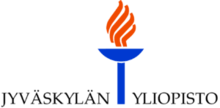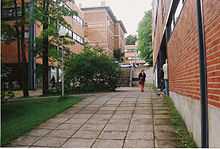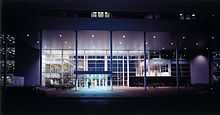University of Jyväskylä
| University of Jyväskylä | |
|---|---|
| Jyväskylän yliopisto | |
 | |
| Latin: Universitas Jyväskyläensis | |
| Motto | Amica veritas |
| Motto in English | Truth is a friend |
| Established | 1934 |
| Type | Public |
| Rector | Dr. Matti Manninen |
| Admin. staff | 2,600 |
| Students | 15,000 |
| Location |
Jyväskylä, Finland 62°14′10.50″N 25°43′57.60″E / 62.2362500°N 25.7326667°ECoordinates: 62°14′10.50″N 25°43′57.60″E / 62.2362500°N 25.7326667°E |
| Website | www.jyu.fi/en/ |







The University of Jyväskylä (Finnish: Jyväskylän yliopisto) is a university in Jyväskylä, Finland. It has its origins in the first Finnish-speaking teacher training college (the so-called Teacher Seminary), founded in 1863. Around 15,000 students are currently enrolled in the degree programs of the university.[1] It is ranked as the second largest university in Finland when measured according to the number of Master’s degrees conferred.
History
The University of Jyväskylä has played a significant role in Finnish cultural history. Founded in 1863, the university has its origins in the first Finnish-speaking teacher training college, the so-called Teacher Seminary. The teacher seminary evolved into the College of Education in 1937, at which time it was given the authority to grant doctorate degrees. In the 1960s, the college started teaching and researching in the sciences and in 1967 was renamed the University of Jyväskylä.
The university offers a wide range of study programmes for Bachelor's or Master's degree conducted in English, many of which are unique in Finland. Natural Sciences, Human Sciences, Sport and Health Sciences as well as Teacher Education are the university's areas of special expertise.
Size
The University has 15,000 students in addition to its adult education students, representing 40,000 students in total. Each year about two thousand new students are admitted and generally only a seventh of applicants are accepted; this makes University of Jyväskylä one of the most popular universities in Finland. Measured according to the number of Master’s degrees conferred, the University of Jyväskylä is ranked as the second largest university in Finland.
Organisation
The University offers undergraduate and postgraduate degrees, teacher training programmes and over 120 subject area disciplines.
The university is currently divided into seven faculties:
- Faculty of Humanities
- Faculty of Information Technology
- Faculty of Education
- Faculty of Sport and Health Sciences
- Faculty of Mathematics and Science
- School of Business and Economics
- Faculty of Social Sciences
Each faculty is active in research and provides undergraduate and graduate degree programs in more than one subject.
Centres of Excellence
Centres of Excellence in Research nominated by the Academy of Finland:
- Nuclear and Accelerator Based Physics (equipped with a cyclotron)
- Biological Interactions Research
- History of a Society: Re-thinking Finland 1400‒2000 (Universities of Tampere and Jyväskylä)
- Interdisciplinary Music Research (Universities of Jyväskylä and Helsinki)
- Philosophical Psychology, Morality and Politics: Human Conduct in the History of Philosophy (Universities of Helsinki and Jyväskylä)
Centre of Excellence in University Education 2010-2012:
- Department of Physics nominated by Finnish Higher Education Evaluation Council (FINHEEC)
International Master's programmes
The University of Jyväskylä offers high quality and tuition-free 2 year Master programmes in English (120 ECTS credits).
- Master of Arts
- Cultural Policy
- Development and International Cooperation
- Educational Leadership
- Education
- ICC Intercultural Communication
- Master of Science
- BPA Biology of Physical Activity
- Corporate Environmental Management
- Development and International Cooperation
- Ecology and Evolutionary Biology
- International Business and Entrepreneurship
- Nanoscience
- Nuclear and Particle Physics
- SEPPRO Sport and Exercise Psychology
- Service Innovation and Management
- SpoSMaPro Sport Management and Health Promotion
- Sustainable Management of Inland Aquatic Resources
- Web Intelligence and Service Engineering
- Master of Social Sciences
- Cultural Policy
- Development and International Cooperation
- Erasmus Mundus Masters Programme
- EMSEP European Masters in Sport and Exercise Psychology
International Cooperation in Education
The University of Jyväskylä aims to offer its students the opportunity to study abroad and internationalisation at home. Therefore, the University of Jyväskylä is active in a variety of international programmes, such as the Lifelong Learning Programme, Nordplus, North-South-South Higher Education Exchange, FIRST and ISEP. The University has also concluded bilateral agreements on student exchange with 25 universities around the world. Altogether, the University is involved in student exchanges with more than 360 universities worldwide.
Campuses

The faculties and departments are mainly located on three campuses: the Main Campus area in the city centre - where the original Teacher Seminary has first started - as well as Mattilanniemi and Ylistönrinne Campuses on opposite shores of Lake Jyväsjärvi, united by a bridge, some 10 minutes walk from the Main Campus area.
Several buildings in the main campus area were designed by famous Finnish architect Alvar Aalto. Aalto received the commission to design the College of Education campus following a competition held in 1951. Aalto played on the idea of Jyväskylä's image among the town's inhabitants as it being the "Athens of the North", and layout of the campus reflects principles of Greek acropolis layouts. His scheme even included a Greek-style open-air theatre, though executed in minimal form.
Buildings in the campus area designed by Alvar Aalto:
- Teachers Training School 1951-54
- Staff housing 1951 (now the Jyväskylä University Museum)
- Student’s Hall of Residence 1952-54 (now the languages department)
- Lozzi and Lyhty staff and student refectories
- Main Building 1954-56
- Swimming Pool 1954-58, 1964, several alterations (called Aalto-Alvari)
- Physical Education Building 1971
- Library 1957 (now the Aalto Reading Room)
In 1969-70 an architectural competition was arranged for the design of new university campus sites at Mattilanniemi and Ylistönrinne. The competition was won by architect Arto Sipinen, who had previously worked in Aalto's office. Sipinen also designed new buildings for the main campus, including a new main library (1974).
Other Institutes
Other institutes within the university include:
- Agora Center
- Kokkola University Consortium Chydenius
- Information Management Centre
- Continuing Education Centre
- Education Evaluation Secretariat
- Institute for Educational Research
- Institute for Environmental Research
- Language Centre
- Open University
- University Library
- University Museum
Student Union
The Student Union of the University of Jyväskylä (JYY) is the students’ very own organization. The basic task of the Student Union is to represent its members and protect their interests and rights at the University as well as in the surrounding society. All degree and exchange students enrolled in the University of Jyväskylä become members of the Student Union.
The Student Union organises:
- Low rent student apartments in Kortepohja Student Village for approximately 2,000 students
- Survival Kits for international students
- Inexpensive health care at the Finnish Student Health Care Services (YTHS)
- Small short-term emergency loans for members
- Various social and free-time activities, such as movie nights, trips, concerts and club nights
- Student newspaper, Jyväskylän Ylioppilaslehti or "Jylkkäri"
- Student cafeteria Ilokivi (lunch for students supported by Kela)
Student Union members are entitled to a student card which can be used to purchase discount transportation tickets (e.g. bus, train) and discount student meals in student campus cafeterias.
Accommodation
- Kortepohja Student Village
Kortepohja Student Village is owned by the Student Union of the University of Jyväskylä. Kortepohja, located about 2.5 kilometres from the Main Campus and city centre, housing approximately 1900 students. All rooms in Kortepohja are rented unfurnished but basic furniture is available in the storage rooms. Laundry facilities, saunas and meeting rooms are available in the buildings.
- Central Finland Student Housing Foundation, KOAS
KOAS offers ca. 3900 apartments all around the Jyväskylä town area. The apartment buildings are conveniently located in the suburbs of Jyväskylä and offer an excellent opportunity to integrate with people outside the University. International students are usually placed in the furnished apartments in Roninmäki, Myllyjärvi and Keltinmäki. Laundry rooms, saunas and store rooms, as well as hobby rooms, are available in the buildings.
Notable People and Alumni
References
- ↑ "Welcome to University of Jyväskylä". Retrieved 14 September 2010.
See also
External links
![]() Media related to University of Jyväskylä at Wikimedia Commons
Media related to University of Jyväskylä at Wikimedia Commons
- University of Jyväskylä - Official site
- Architecture of Jyvaskyla University by Alvar Aalto on Architectuul